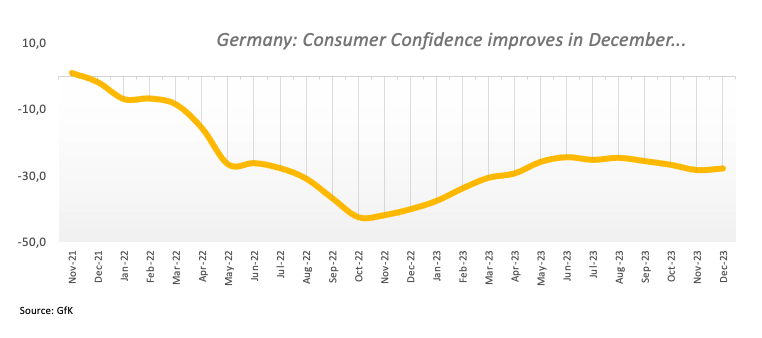- The Euro picks up extra pace against the US Dollar.
- European stocks en route to a negative close on Tuesday.
- US Consumer Confidence surprised to the upside in November.
The Euro manages to gather extra steam against the US Dollar, encouraging EUR/USD to advance to new monthly highs in the 1.0980-1.0985 band on Tuesday, re-shifting its attention to the key threshold of 1.1000 the figure.
On the flip side, the Greenback breaks below the key support at 103.00 for the first time since late August when tracked by the USD Index (DXY), always against the backdrop of the mixed performance in US yields across different maturities.
There are no changes to the monetary policy front, as investors continue to factor in the likelihood of interest rate cuts by both the Federal Reserve (Fed) and the European Central Bank (ECB) at some point in the spring of 2024.
On the domestic calendar, Consumer Confidence in Germany, measured by GfK, improved marginally to -27.8 in December, while Consumer Confidence in France edged higher to 87 in November.
In the US docket, the Conference Board’s Consumer Confidence came in above estimates at 102.0 for the current month (from 102.6), and the FHFA’s House Price Index rose at a monthly 0.6% in September.
Additionally, Chicago Fed Austan Goolsbee (voter, centrist), FOMC Christopher Waller (permanent voter, hawk), FOMC Michelle Bowman (permanent voter, centrist), and FOMC Michael Barr (permanent voter, centrist) are all due to speak.
Daily digest market movers: Euro now looks at a visit to 1.1000
- The EUR puts the 1.0980 region to the test against the USD.
- US and German yields trade in a mixed fashion on Tuesday.
- Markets see the Fed starting its interest rate cuts in Q2 2024.
- Investors’ consensus place the ECB extending its pause until H2 2024.
- BoE's Dave Ramsden sees upside risks to UK inflation.
- ECB’s Joaquim Nagel does not rule out rate hikes if inflation picks up pace.
- RBA’s Michele Bullock kept the cautious tone earlier in the Asian session.
Technical Analysis: Euro maintains the bullish stance unchanged so far
EUR/USD’s upside momentum picks up extra pace and re-focuses on the key 1.1000 barrier.
The November high of 1.0965 (November 21) is now the immediate goal for bulls ahead of the critical 1.1000 level. Further north, EUR/USD might face resistance around the August top of 1.1064 (August 10) and another weekly peak of 1.1149 (July 27), both of which precede the 2023 high of 1.1275 (July 18).
In the meanwhile, any corrective dips should find support initially at the key 200-day SMA at 1.0812, followed by the temporary 55-day SMA at 1.0665. South from here comes the weekly low of 1.0495 (October 13) prior to the 2023 low of 1.0448 (October 3).
Overall, the pair's chances should remain strong as long as it stays above the 200-day SMA.
Euro FAQs
What is the Euro?
The Euro is the currency for the 20 European Union countries that belong to the Eurozone. It is the second most heavily traded currency in the world behind the US Dollar. In 2022, it accounted for 31% of all foreign exchange transactions, with an average daily turnover of over $2.2 trillion a day.
EUR/USD is the most heavily traded currency pair in the world, accounting for an estimated 30% off all transactions, followed by EUR/JPY (4%), EUR/GBP (3%) and EUR/AUD (2%).
What is the ECB and how does it impact the Euro?
The European Central Bank (ECB) in Frankfurt, Germany, is the reserve bank for the Eurozone. The ECB sets interest rates and manages monetary policy.
The ECB’s primary mandate is to maintain price stability, which means either controlling inflation or stimulating growth. Its primary tool is the raising or lowering of interest rates. Relatively high interest rates – or the expectation of higher rates – will usually benefit the Euro and vice versa.
The ECB Governing Council makes monetary policy decisions at meetings held eight times a year. Decisions are made by heads of the Eurozone national banks and six permanent members, including the President of the ECB, Christine Lagarde.
How does inflation data impact the value of the Euro?
Eurozone inflation data, measured by the Harmonized Index of Consumer Prices (HICP), is an important econometric for the Euro. If inflation rises more than expected, especially if above the ECB’s 2% target, it obliges the ECB to raise interest rates to bring it back under control.
Relatively high interest rates compared to its counterparts will usually benefit the Euro, as it makes the region more attractive as a place for global investors to park their money.
How does economic data influence the value of the Euro?
Data releases gauge the health of the economy and can impact on the Euro. Indicators such as GDP, Manufacturing and Services PMIs, employment, and consumer sentiment surveys can all influence the direction of the single currency.
A strong economy is good for the Euro. Not only does it attract more foreign investment but it may encourage the ECB to put up interest rates, which will directly strengthen the Euro. Otherwise, if economic data is weak, the Euro is likely to fall.
Economic data for the four largest economies in the euro area (Germany, France, Italy and Spain) are especially significant, as they account for 75% of the Eurozone’s economy.
How does the Trade Balance impact the Euro?
Another significant data release for the Euro is the Trade Balance. This indicator measures the difference between what a country earns from its exports and what it spends on imports over a given period.
If a country produces highly sought after exports then its currency will gain in value purely from the extra demand created from foreign buyers seeking to purchase these goods. Therefore, a positive net Trade Balance strengthens a currency and vice versa for a negative balance.
Information on these pages contains forward-looking statements that involve risks and uncertainties. Markets and instruments profiled on this page are for informational purposes only and should not in any way come across as a recommendation to buy or sell in these assets. You should do your own thorough research before making any investment decisions. FXStreet does not in any way guarantee that this information is free from mistakes, errors, or material misstatements. It also does not guarantee that this information is of a timely nature. Investing in Open Markets involves a great deal of risk, including the loss of all or a portion of your investment, as well as emotional distress. All risks, losses and costs associated with investing, including total loss of principal, are your responsibility. The views and opinions expressed in this article are those of the authors and do not necessarily reflect the official policy or position of FXStreet nor its advertisers. The author will not be held responsible for information that is found at the end of links posted on this page.
If not otherwise explicitly mentioned in the body of the article, at the time of writing, the author has no position in any stock mentioned in this article and no business relationship with any company mentioned. The author has not received compensation for writing this article, other than from FXStreet.
FXStreet and the author do not provide personalized recommendations. The author makes no representations as to the accuracy, completeness, or suitability of this information. FXStreet and the author will not be liable for any errors, omissions or any losses, injuries or damages arising from this information and its display or use. Errors and omissions excepted.
The author and FXStreet are not registered investment advisors and nothing in this article is intended to be investment advice.
Recommended content
Editors’ Picks

EUR/USD remains bid around 1.1200, USD melts on tariff concerns
EUR/usd maintains its bullish stance well in place on Thursday, reaching the 1.1200 barrier and beyond on the back of intense selling pressure on the US Dollar, fuelled by concerns over the impact of Trump's tariffs on the US economy.

GBP/USD settles around 1.2950 on weaker Dollar
GBP/USD advances markedly and extends its breakout of the 1.2900 hurdle amid global trade war jitters and a severe sell-off in the Greenback, which was exacerbated following news of 145% US tariffs on China.

Gold resumes record rally, reaches $3,175
Gold extended its record rally on fresh tariff-related headlines, trading as high as $3,175 a troy ounce in the American session. The White House confirmed 35% levies on Mexico and Canada, 145% on Chinese imports, resulting in a fresh round of USD selling and pushing XAU/USD further up.

Cardano stabilizes near $0.62 after Trump’s 90-day tariff pause-led surge
Cardano stabilizes around $0.62 on Thursday after a sharp recovery the previous day, triggered by US Donald Trump’s decision to pause tariffs for 90 days except for China and other countries that had retaliated against the reciprocal tariffs announced on April 2.

Trump’s tariff pause sparks rally – What comes next?
Markets staged a dramatic reversal Wednesday, led by a 12% surge in the Nasdaq and strong gains across major indices, following President Trump’s unexpected decision to pause tariff escalation for non-retaliating trade partners.

The Best brokers to trade EUR/USD
SPONSORED Discover the top brokers for trading EUR/USD in 2025. Our list features brokers with competitive spreads, fast execution, and powerful platforms. Whether you're a beginner or an expert, find the right partner to navigate the dynamic Forex market.




